Article
New intracanalicular punctum plug relieves dry eye
The Form Fit intracanalicular punctum plug (Oasis Medical) is a new option for patients who need long-term relief from dry eye problems, offering advantages such as patient tolerability, uniform sizing, and easy insertion and removal, according to several specialists familiar with the recently approved product.

Form Fit plugs are "well tolerated by the patients, and they're completely easy to put in," said Jacqueline Griffiths, MD, medical director of NewView Laser Eye, Reston, VA.
Since the punctum plug expands to fit the punctal cavity, one size fits every patient and there is no need to use a sizer to get the correct fit, which is convenient for the physician and patient, Dr. Griffiths said.
Dr. Griffiths has been using the Form Fit plugs for several months, since they became commercially available following last fall's FDA approval.
The Form Fit plug is made of a hydrogel that expands into a soft, pliable, gelatinous material when it comes into contact with tear film.
Unlike silicone plugs, it does not have a cap.
The punctum plug comes preloaded on an inserter whose polyimide tip is inserted into the punctum; the inserter handle is then compressed to expel the plug.
Once inserted, the Form Fit plug absorbs tear fluid and expands about 20 times in volume over a period of approximately 10 minutes, filling and conforming to the vertical canaliculus.
"My threshold for using punctal plugs is low, and it's become even lower with these [Form Fit]," Dr. Griffiths said. She often uses them in combination with cyclo-sporine ophthalmic emulsion 0.05% (Restasis, Allergan), since it takes about a month before the drug becomes effective and the plugs help provide relief in the interim as well as in conjunction with drops on an ongoing basis.
"Patients get immediate relief," Dr. Griffiths said. "I've gotten feedback from patients that they really like the results, that they have to use the artificial tears less often, and that they don't feel the plugs at all.
"This is my plug of choice unless I see that the dry eye situation is a temporary problem, in which case I would use the 3-month plug," Dr. Griffiths added.
Many patients are apprehensive about getting punctum plugs and fear that the procedure will be invasive but are pleasantly surprised at how easily the Form Fit plugs are inserted, Dr. Griffiths said, unlike silicone permanent plugs that sometimes required extended dilation and a longer, more difficult insertion process.
"There are some drawbacks, as there are to any product, but very few," she said. In about 2% of the instances in which she has attempted to insert a plug, it has become stuck on the end of the injector and had to be discarded.
Dr. Griffiths described this as a manufacturing problem with the slightly sticky hydrogel material and added that she had not experienced any patient-related problems with the Form Fit. "The manufacturer has responded to this problem and redesigned its injector recently [to address this issue]," Griffiths said.
Fares well in dry, gritty regions Edward D. Glinski, DO, MBA, Heritage Eye Associates and Surgicenter of Oklahoma in Oklahoma City, also uses Form Fit plugs extensively in his practice. He implanted about 120 Form Fit plugs in the first 2 months that the product was commercially available, with such heavy use attributable to the high incidence of dry eye in the harsh Oklahoma environment and his openness toward any new technology that might help his patients.
Newsletter
Don’t miss out—get Ophthalmology Times updates on the latest clinical advancements and expert interviews, straight to your inbox.





